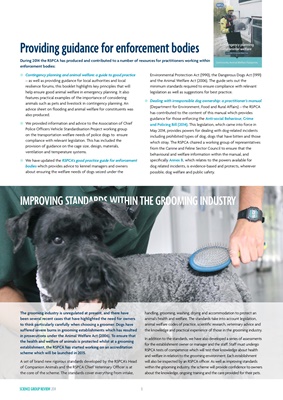
SCIENCE GROUP REVIEW 2014 8
Providing guidance for enforcement bodies
During 2014 the RSPCA has produced and contributed to a number of resources for practitioners working within
enforcement bodies:
l Contingency planning and animal welfare: a guide to good practice
- as well as providing guidance for local authorities and local
resilience forums, this booklet highlights key principles that will
help ensure good animal welfare in emergency planning. It also
features practical examples of the importance of considering
animals such as pets and livestock in contingency planning. An
advice sheet on flooding and animal welfare for constituents was
also produced.
l We provided information and advice to the Association of Chief
Police Officers Vehicle Standardisation Project working group
on the transportation welfare needs of police dogs to ensure
compliance with relevant legislation. This has included the
provision of guidance on the cage size, design, materials,
ventilation and temperature systems.
l We have updated the RSPCA's good practice guide for enforcement
bodies which provides advice to kennel managers and owners
about ensuring the welfare needs of dogs seized under the
Environmental Protection Act (1990), the Dangerous Dogs Act (1991)
and the Animal Welfare Act (2006). The guide sets out the
minimum standards required to ensure compliance with relevant
legislation as well as suggestions for best practice.
l Dealing with irresponsible dog ownership: a practitioner's manual
(Department for Environment, Food and Rural Affairs) - the RSPCA
has contributed to the content of this manual which provides
guidance for those enforcing the Anti-social Behaviour, Crime
and Policing Bill (2014). This legislation, which came into force in
May 2014, provides powers for dealing with dog-related incidents
including prohibited types of dog, dogs that have bitten and those
which stray. The RSPCA chaired a working group of representatives
from the Canine and Feline Sector Council to ensure that the
behavioural and welfare information within the manual, and
specifically Annex B, which relates to the powers available for
dog related incidents, is evidence-based and protects, wherever
possible, dog welfare and public safety.
The grooming industry is unregulated at present, and there have
been several recent cases that have highlighted the need for owners
to think particularly carefully when choosing a groomer. Dogs have
suffered severe burns in grooming establishments which has resulted
in prosecutions under the Animal Welfare Act (2006). To ensure that
the health and welfare of animals is protected whilst at a grooming
establishment, the RSPCA has started working on an accreditation
scheme which will be launched in 2015.
A set of brand new rigorous standards developed by the RSPCA's Head
of Companion Animals and the RSPCA Chief Veterinary Officer is at
the core of the scheme. The standards cover everything from intake,
handling, grooming, washing, drying and accommodation to protect an
animal's health and welfare. The standards take into account legislation,
animal welfare codes of practice, scientific research, veterinary advice and
the knowledge and practical experience of those in the grooming industry.
In addition to the standards, we have also developed a series of assessments
for the establishment owner or manager and the staff. Staff must undergo
RSPCA tests of competence which will test their knowledge about health
and welfare in relation to the grooming environment. Each establishment
will also be inspected by an RSPCA officer. As well as improving standards
within the grooming industry, the scheme will provide confidence to owners
about the knowledge, ongoing training and the care provided for their pets.
IMPROVING STANDARDS WITHIN THE GROOMING INDUSTRY